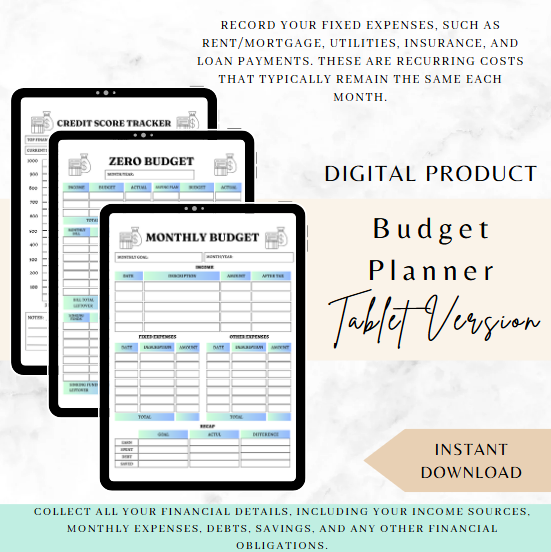
Budget Planner
Digital Product
$35.00
Introducing the ultimate Budget Planner Tablet Version! This all-inclusive planner is crafted specifically for tablet users, designed with sections for credit score tracking, zero-based budgeting, and meticulous monthly budget planning. It’s your go-to tool to streamline your fixed expenses, various income sources, debts, savings, and other financial commitments. Available in elegant colors and optimized for all tablet sizes, this planner ensures you stay on top of your finances with ease and style.
Using a budget planner template is a straightforward way to manage your finances. Here's a step-by-step guide:
1. Gather Financial Information
Collect all your financial details, including your income sources, monthly expenses, debts, savings, and any other financial obligations.
2. Choose the Right Template
Select a budget planner template that suits your needs. Templates vary from simple spreadsheets to more detailed planners with categories for income, expenses, savings goals, and debt repayment.
3. Input Your Income
Enter all your income sources in the designated section of the template. This includes your salary, side income, freelance earnings, and any other regular income.
4. List Fixed Expenses
Record your fixed expenses, such as rent/mortgage, utilities, insurance, and loan payments. These are recurring costs that typically remain the same each month.
5. Record Variable Expenses
Input your variable expenses, which can change month to month. This includes groceries, transportation, dining out, entertainment, and other discretionary spending.
6. Set Savings Goals
Allocate a portion of your income to savings goals. This could be an emergency fund, retirement savings, or specific goals like a vacation or down payment on a house.
7. Track Debt Repayment
If you have debts, include them in the budget planner. Track how much you pay each month and monitor your progress in reducing the overall balance.
8. Review and Adjust Monthly
At the end of each month, review your actual spending against your budgeted amounts. Adjust the budget for the next month based on any changes in your income or expenses.
9. Analyze Spending Trends
Use the template’s summaries or charts (if available) to analyze your spending trends. This can help you identify areas where you might be overspending and where you can cut back.
10. Stay Consistent
Regularly update the template with new income and expenses to keep your budget accurate and useful. Consistency is key to making the most out of your budget planner.
11. Reflect on Your Progress
Periodically review your progress towards your financial goals. Celebrate the small wins and adjust your strategy if needed to stay on track.
By following these steps, you'll be able to use a budget planner template effectively, helping you gain control over your finances and work towards your financial goals.
